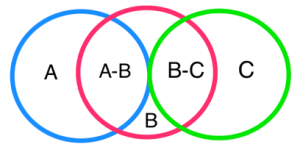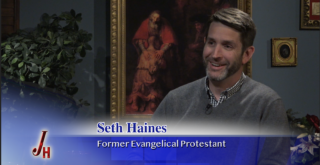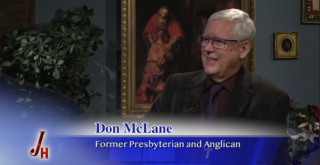After 40 years of ministry, half as a Protestant and half as a Catholic, I’ve come to the deep conviction that every single person needs continual conversion, especially when it comes to me. I’m constantly being startled by new aspects of this wonderful Catholic faith, which I thought I had come to understand, but which in reality I understand only as “in a mirror dimly.” And I believe the cause behind most of the conflicts that divide Christians stems from this need for continual conversion, from the top down.
Allow me to illustrate this with a diagram:

The above three circles represent:
CIRCLE A: An individual’s formation before and apart from the person’s formation as a Catholic Christian. This represents all the sources of information—pastors, teachers, books, media, experiences, family, friends, etc.—that form an individual’s understanding of God, life, religion, self, etc., before the person receives specific instruction as a Catholic Christian. For converts to the Catholic faith, this includes their non-Catholic formation and convictions as well as any non-Catholic bias and false representations of Catholic beliefs. For life-long Catholics, this sometimes could include childhood formation at home, school, or parishbefore they experienced an “adult awakening” which instills within them a desire to “relearn” their faith and live it more fully and faithfully.
CIRCLE B: The new “Catholic” sources of formation that awaken an individual’s desire for a deeper understanding of the Catholic faith and/or a conversion to the Catholic religion, as well as the ongoing formation of that individual’s understanding of the faith. This includes teachers, books, media, experiences, family, friends, even sometimes Catholic television programs.
CIRCLE C: The true fullness of the Catholic faith, teaching, and experience, which is not necessarily equivalent to (B) what Catholic teachers, writers, media spokesmen, or even some members of the Catholic clergy proclaim. This represents what is in fact true.
The following combination of these three circles is one way of representing an individual’s present formation in relation to the three sources mentioned:

In other words, there are at least five kinds of knowledge and/or experiences that make up our present state of formation:
“A” represents the residual “baggage” of our past knowledge and experience, which continues, sometimes subconsciously, on into our present religious life, but still needs examination and correction.
“A-B” represents those aspects of our past knowledge and experience that did not need to change as a result of our conversion, areas of equivalence.
“B” represents things we learned from “Catholic” sources that are not precisely in line with the fullness of the truth; things we were taught to be true and necessary by sincere believing Catholics, but instead are less than accurate expressions of the Catholic faith, some of which may remain undetected until challenged.
“B-C” represents those aspects of Catholic truth we learned, which required radical changes from our past. Doctrines, ways of living, ethics, and morals, that we had to relearn or correct.
“C” represents those aspects of Catholic truth that we have yet to learn.
For example, in my own journey:
“A” includes lingering presumptions I have about the surety of my salvation, based on my previous longstanding presumptions of “once saved—always saved.”
“A-B” includes my continuing belief in the Trinity and Mary as Mother of God.
“B” includes certain devotional practices and radical misrepresentations of Church teachings.
“B-C” includes many things, like the trustworthiness of Sacred Tradition, the authority of the Magisterium in union with Peter, and intercession of the Saints.
“C” includes lots of stuff (!) I’ve yet to learn!
If you reflect on the significance of this diagram, you will see how different it is for each person, sometimes radically different even between life-long Catholics. We each have differing levels of residual baggage from our formative years (A), of less-than-accurate information we’ve picked up along the way from less-than-accurate sources (B), and, of course, lots of the truth we’ve yet to learn (C).
And it is the conflict of these differences that continues to plague the Christian community, because every Christian confronts other Christians with differing combinations of formation, which is one of the reasons every single one of us (maybe mostly me) needs continual conversion.
When St. Augustine said, “In essentials unity, non-essentials diversity, in all things charity,” he didn’t foresee the extent to which modern Christians are divided over what are essentials and non-essentials, and the extremes to which we would forget charity.
I chose not to say that we need “continual catechetical instruction,” because what is needed is not merely a matter of continual education, but of spiritual change, a change that is primarily the work of God, not of ourselves, a growth in holiness.
What this requires is a continual recognition of the inadequacies, holes, and blind-spots in our spiritual formation, and a humble willingness to continually examine our understanding and practice of the faith. As Jesus himself instructed in his Sermon on the Mount, we need the “attitudes of the Beatitudes”: poverty of spirit, mourning for our sins, meekness, a hungering and thirsting for righteousness, purity of heart, etc., all of which lead us to grow more deeply in our union with Christ and His Church.
Our Lord once made a disturbing revelation to his followers:
Not everyone who says to Me, ‘Lord, Lord,’ shall enter the kingdom of heaven, but he who does the will of My Father in heaven. Many will say to Me in that day, ‘Lord, Lord, have we not prophesied in Your name, cast out demons in Your name, and done many wonders in Your name?’ And then I will declare to them, ‘I never knew you; depart from Me, you who practice lawlessness! (Mt 7:21-23)
How can our Omniscient Lord Jesus not “know” us? He knows us each better than we know ourselves! Most sincere Christians do all we can to “know, love, and serve” Him, but how is it that He might fail to know us?
Remember those five maidens who did not have enough oil for their lamps? Why didn’t the bridegroom let them into the marriage feast? Because He said, “I do not know you” (Mt 25:12).
In our journeys of faith, are we continually preparing ourselves to meet Him? And when we do, will He know us?
In light of the diagram, I believe one way we can become better known by Him, is through continual self-examination, identifying residual baggage that holds us back (A) as well as inaccurate new information (B) that needs to be purged from our hearts and minds, so that our knowledge and practice can grow more in union with Him and His Church (C).
This is essentially what Saint Paul instructed the Christians at Corinth: “Since we have these promises, beloved, let us cleanse ourselves from every defilement of body and spirit, and make holiness perfect in the fear of God” (2 Cor 7:1).










